Originality and femininity to many things of women lace adds to the wardrobe, crocheted. Numerous patterns and descriptions of such designs can be found on the Internet. They vary both in size and in shape. How to calculate the required length, select yarn and hook, and apply a particular pattern is described further in the article.
A bit of history
Crochet lace, the patterns and descriptions of which can be found in abundance in modern magazines, knitting books and the Internet, have long been considered the prerogative of the rich and noble. It is not without reason that in the past, women seamstresses and knitters were especially honored, who were settled directly in the palaces to serve the royal families and their entourage.
Craftswomen spun the finest linen and wove amazing lace for the clothes of majestic persons. Not a single snow-white undershirt could do without the most beautiful lace framing the bottom of the sleeves, neckline and hem.
Many of the royal families' representatives opened special handicraft schools under their patronage, where the most experienced and gifted craftswomen of the palace became teachers. By passing on their knowledge and skills to young girls, they provided them with a comfortable future in good conditions.
Necessary tools
Basically, thin, openwork lace is made from the corresponding thin yarn of various compositions. Ribbons knitted from natural cotton without mercerization are distinguished by a rougher and denser structure. Mercerized cotton threads give the product softness, some shine, improved organoleptic qualities. Such raw materials are smooth, high-quality, effective in finished form, comfortable to work with.
Acetate or silk is also an excellent option for knitting openwork lace stripes. Such yarn is flexible in the process and has an attractive appearance in the finished form. After finishing work using this category of threads, it is necessary to very carefully secure their ends, as they tend to unravel.
In rare cases, thin acrylic is used. It is mainly used to decorate the lower edge of reinforced skirts, dresses, sarafans, tunics, and sweaters.
Any yarn is selected to match the color of the main product or a contrasting shade is used to accentuate either the item itself or the trim.
The most common hook sizes for this type of knitting are from 0.75 to 3. A more specific thickness of the tool depends on the same parameter of the selected yarn.
When selecting threads and hook size, it is necessary to take into account the density of knitting, as it is different for all needlewomen. It should also be remembered that using a tool of a thinner thickness than the yarn will lead to an increase in the density of the fabric. And vice versa, using a hook of a larger number will ultimately give a looser and more openwork knitting structure.
Variety of lace techniques
Crochet lace, the patterns and descriptions of which allow us to judge the simplicity or complexity of the pattern, can be made in various techniques. Based on their experience, skills and knowledge, each knitter is able to choose the most optimal one for herself. Currently, there are several techniques for knitting openwork lace.
Among them:
- tape,
- fillet,
- Bruges,
- Irish.
Each of them has its own individual features of execution and level of complexity. Further, more detailed information is presented, revealing the essence of the listed techniques.
Ribbon lace
This technique allows you to make openwork lace in the form of ribbons that differ in width, side configuration, structure. This depends on their purpose. This knitting is used both for decorating clothing sections and for making the entire product. In most cases, the difference between such lace ribbons is the direction of work and the structure of the pattern itself.
In the first case, the ribbon is knitted in longitudinal rows, the length of which depends on the parameters of the edge being designed. If there are tucks or small folds, their number and size are calculated in advance. This should be done as accurately as possible to avoid unnecessary bulges or tightened areas. As a rule, lace made using this technique has one smooth side and one figured side. The first is sewn to the edge of the product, and the second serves as a direct design of its edge. The advantage of this knitting is the ability to adjust the width of the ribbon if it is necessary to increase the length of clothing parts.
The second version of the ribbon lace technique involves performing work in the transverse direction, i.e. the width of the ribbon is fixed, and the length can be adjusted if necessary. This is its positive point. The peculiarity of this knitting method is that both sides of the ribbon have a similar structure. It can be both symmetrical and sequential (wavy). The fixed width of each ribbon pattern allows you to calculate the required number of stripes for making any type of clothing.
Having pre-knitted a sample according to the selected scheme, its width is compared with the constructed pattern and the required number of ribbons is determined. Experienced craftswomen believe that the number of knitted fragments should be even (if the width of the pattern exceeds 2-3 cm). But this statement is relative and is valid only in cases where the female figure is close to standard sizes. In other options, everything is regulated according to the pattern drawing.
When knitting a product from lace ribbons, special attention should be paid to their connection with each other. Craftswomen with extensive experience do this in the process of knitting the next strip. But for beginners this can cause difficulties, so it is better to connect the fragments after making all the necessary number of motifs.
The connection is made with a sewing needle and thread. The tapes should be sewn only at the points of contact, and not along the entire length. To determine these areas, the strips are placed end to end on a hard surface, aligned along the bottom edge and the adhesion points are marked.
Fillet lace
Crochet filet lace (diagrams and description below) looks like an ornament applied to a fine mesh. This does not mean that a regular mesh is first knitted and then floral or geometric elements are woven into it. All work is done simultaneously, changing only the density by the number of double crochets or single crochets on the same number of loops of the previous row. This technique of knitting lace is quite simple, but also has its own peculiarity.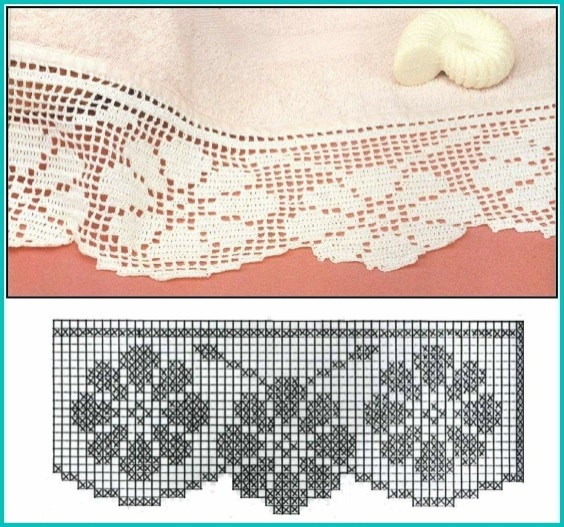
It consists in the fact that in the purl rows the pattern changes in the same way as in the front rows. In most patterns of other techniques, the purl rows are a repetition of the front rows. If a similar process is applied in filet knitting, the pattern will acquire a stretched in height appearance, which will distort its natural size. It is precisely ignoring this feature in filet knitting that leads to a common mistake.
Depending on the location of the pattern on the diagram and the design of one of the sides, the direction of knitting the lace is determined. It can be either longitudinal or transverse. If one of the edges is carved, then the work is carried out in transverse rows, if it is even, then knitting is carried out in longitudinal rows.
According to the recommendations of experienced knitters, when making a direct pattern on the grid, it is better to fill each cell with three columns instead of two. This way, the gaps between them are reduced, the density is increased, and the fragment of the pattern itself is more clearly outlined on the rest of the fabric.
This type of lace knitting technique is not at all complicated and any beginner can handle it. To master it, you only need to be able to perform an air loop, double crochets and single crochets.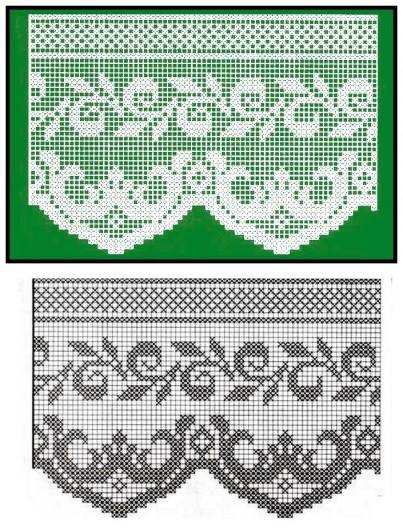
But special attention should be paid to calculating the length of the lace tape when decorating the bottom of the product, sleeve or neck. In order for the knitted strip to fall exactly into the joint, without disturbing the overall pattern, it is necessary to measure the width of the pattern rapport on the sample and compare it with the length of the cut being decorated.
It should fit a whole number of rapports. Only in this case the joining of the edges of the tape will be correct. If the parameters of the openwork strip and the product do not match, it is recommended to adjust the pattern scheme or choose another option.
Bruges lace technique
Crochet lace, the patterns and descriptions of which are presented below, are made using the Bruges knitting technique. This method is also not complicated in its structure. But the difficulty lies in its final design, that is, connecting a small knitted ribbon into a full-fledged ornament. This requires spatial thinking, precise calculation and utmost attention. The slightest failure in the work leads to subsequent maximum distortion of the appearance and the impossibility of performing subsequent actions.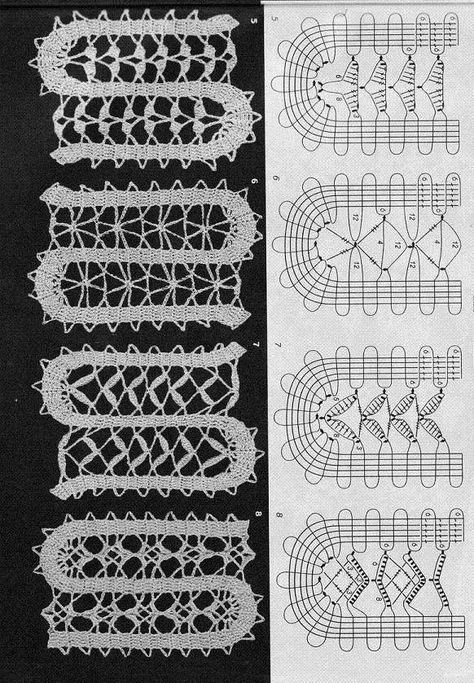
The main skill that a beginner knitter should have when using this technique is the ability to perform a chain stitch and double crochets.
This is due to the structure of the resulting lace, which consists of alternating several double crochet stitches and chain arcs of air loops.
It seems to be nothing complicated, but the snag is in the following. In the process of knitting a thin braid, you should connect its arcs to each other according to the chosen pattern.
This is where a failure can occur. Therefore, in places where the arcs are connected, you should be extremely careful and additionally calculate the number of air chains involved in the coupling.
Even in a simple “snake” you can make a mistake, not to mention complex and intricate compositions.
When using Bruges lace as a decoration for the bottom of a product, sleeves, it is necessary to first compare the dimensions of the length of the processed cut and the finished lace tape. To calculate this parameter, you need to take not the rapport of the tape itself, but a repeating fragment of the entire pattern. The length of the edge of the product should include only an integer number of rapports of the ornament.
In appearance, products made in the Bruges technique have a striking resemblance to lace woven on bobbins. Therefore, lovers of this category of handicrafts and those who do not own it, can realize their dream with the help of a similar crochet technique. The only difference in such works will be the thickness of the lace. In bobbin weaving, the fabric has a two-layer structure, and in crocheting - a three-layer structure.
Lace from individual motifs
Also, one of the interesting and beautiful ways of knitting lace ribbons is the technique of individual motifs.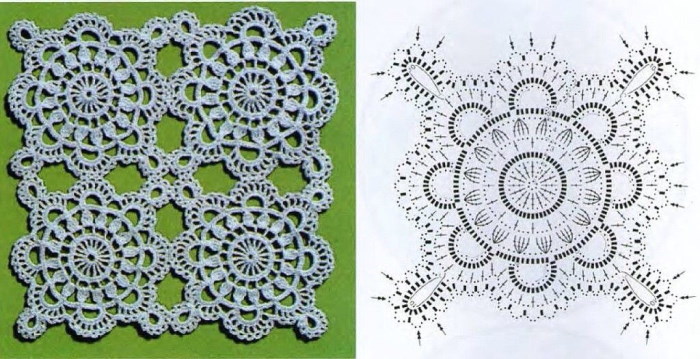
According to their configuration they can be:
- square,
- round,
- oval,
- triangular,
- diamond-shaped,
- trapezoidal.
The square and diamond shaped elements, when joined together, create a lace ribbon with straight edges on both sides.
Round and partially oval (if the coupling is made with the end, elongated sides to each other or symmetrically in pairs) fragments form symmetrically rounded figured edges. If the oval-shaped motifs are connected to each other in one direction, then the sides have a wavy edge.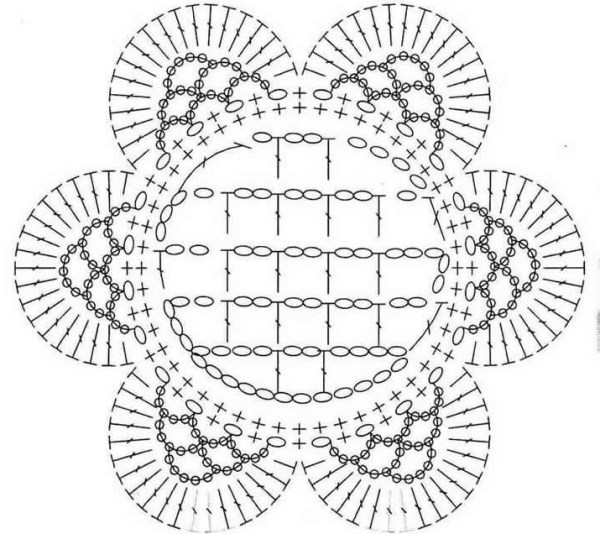
Triangular elements, arranged alternately in the forward and reverse position, form a smooth, beautiful lace strip, visually divided into parts by opposite diagonals. Similar fragments, but placed in one direction, create a magnificent ribbon with large "teeth". The second, smooth side is attached to the cut of the product. Lace stripes made of trapezoidal motifs will have a similar appearance.
It is advisable to join individual fragments when knitting the outer row of the element, but first mark the beginning and end of this process so as not to tighten or stretch the finished ribbon. Also pay careful attention to the arrangement of motifs when joining into a circle so as not to disrupt the integrity of the pattern.
Irish Technique
Crochet lace, the patterns and descriptions of which are shown below, are made in the most complex technique - Irish. Products knitted using the Irish method cannot be exactly repeated. This is the master's improvisation, made in a single copy. It consists of a set of individual elements of various configurations, assembled into a common composition using an irregular grid.
For beginners, this method is very difficult. It is very difficult to predict the future "picture" of the lace, so you will need to improvise a lot during the work. People who do not have spatial thinking, extensive imagination, great experience and skills may not be able to handle this technique.
Irish lace consists of both large and small details of the plant world, geometric figures, ornate and fairy-tale motifs, chains, cords, skillfully introduced into the fabric in a certain sequence.
Chaotically arranged fragments will not create a positive effect. Therefore, experienced needlewomen carefully think over the configuration of the future composition, knit the required number of parts, make a model of the pattern. And only when they are satisfied with the overall picture, the fragments are fixed on the surface and their coupling is carried out with an irregular grid.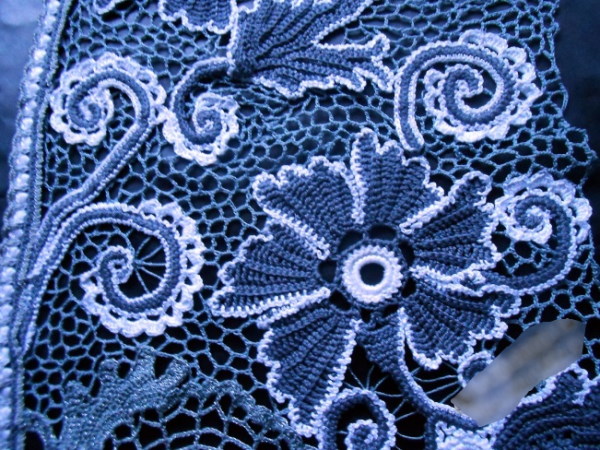
The Irish lace technique involves the use of a wide variety of techniques and many loops. And "planting" all the elements on a common grid requires many years of skills that exclude distortion of the pattern, distortions of the canvas, the presence of too large or small inter-motif spaces. Therefore, it is quite difficult for a novice needlewoman to create lace using this method using the entire range of available tools.
Features of lace application
Depending on what a particular type of lace ribbon is used for, there are specific features of their use. As mentioned above, when decorating the bottom of a product, its sleeves, and neckline in a closed circle, it is necessary to accurately calculate the number of pattern rapports included in the length of the cut. This ensures an accurate connection of the beginning and end of the lace without violating the integrity of the overall pattern.
With another option for decorating the edges of products, for example, along the perimeter, the peculiarity of making openwork stripes is already different. Here the question arises of how to tie right angles with elements of the main ornament without distorting the evenness of the fabric.
In these situations, the same loops that are used in the main pattern come to the rescue, but made several pieces from one loop of the previous row. Such combinations are carried out directly above the top of the corner. But the number of loops should be so much that the rest of the canvas remains even, without any bulges or ties.
Crochet lace, some patterns and descriptions of which are presented in this article, are capable of not only creating a unique feminine sophisticated image, but also bringing innovation to existing things, giving them a unique twist and charm.
Video about crochet lace
Simple crochet lace:
